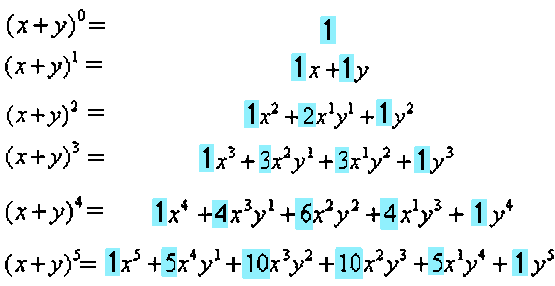-
A Binomial Distribution, Explained More Slowly
-
- An Action with Only Two Possible Outcomes
-
Binomial in algebra means the sum of two terms.

- as in the above
binomial expansions with Pascal's Triangle highlighted in blue.
-
- Binomial in probability begins with an action, or trial, having only two possible outcomes.
The two and only two possible results of the action are success and failure.
-
- Let the probability of a successful outcome of this action be the value p and the probability of failure be the value q.
Because the sum of all the probabilities for an experiment is 1 and since there are only two outcomes, p+q=1 and q=1-p.
-
- The action might be as simple as tossing a coin to obtain a head or a tail.
One of the outcomes is declared to be a success and the other outcome is declared to be a failure.
It doesn't matter which. In the example at the top of the page, obtaining a head on the toss was declared to be a success.
-
- The outcomes need not be equally likely. If the coin is fair, the probability of success, p, is 1/2 and the probability of failure, q, is also 1/2, since, 1/2 + 1/2 = 1, or 1 - 1/2 = 1/2.
-
- If the probability of success in this action, p, is 2/5 or .4, the probability of failure of this action, q, is 1 - 2/5, or .6.
-
- Each Performance of the Action Is Independent
-- Each Trial Is Independent.
- Independent -- each trial stands alone.
-
- The result of one trial has no infuence on any other trial.
-
- When a coin is flipped, the outcome is not influenced by the last flip of the coin.
-
- An only two-possible-outcome experiment, repeated a certain number of independent times is called
binomial. The distribution or function has as a variable x, the number of successes. The other required parameters are n, the number of
independent trials, and p, the probability of success on each trial. The probability of failure on each trial is q, or 1 - p.
|



![[MC,i. Home]](http://www.mathnstuff.com/math/spoken/here/1gif/mcihome.gif)
![[Table]](http://www.mathnstuff.com/math/spoken/here/1gif/table.gif)
![[Words]](http://www.mathnstuff.com/math/spoken/here/1gif/words.gif)

![[this semester's schedule w/links]](http://www.mathnstuff.com/gif/semestr.gif)
![[Good Stuff -- free & valuable resources]](http://www.mathnstuff.com/gif/goods.gif)
![[last]](http://www.mathnstuff.com/math/spoken/here/1gif/last.gif)
![[next]](http://www.mathnstuff.com/math/spoken/here/1gif/next.gif)